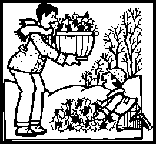

Seasons Of The Year


Seasons Of The Year
A season is defined as one of the four divisions of the year, as determined by the changes in the relative lengths of day and night as the earth moves around the sun. These changes affect the amount of heat received from the sun at a given time of year, which in turn affects average temperatures.
The differences between the seasons are most evident in the temperate regions of the earth and least evident near the equator. The polar regions always remain cold, but temperatures fluctuate on a seasonal basis. The seasons exist because the earth's axis of rotation is inclined at an angle to the plane of the ecliptic - that is, the plane of the earth's orbital path around the sun. This means that as the earth moves around the sun in the course of a year, the orientation of its Northern and Southern Hemispheres slowly changes.
From about March 21 to September 23, more of the Northern than the Southern Hemisphere faces toward and is warmed by the sun. the situation is reversed from September 23 to March 21. Thus, beginning with March 21 in the Northern Hemisphere, the seasons run as follows:
The seasons are different in the Southern Hemisphere, summer and winter are reversed, as are spring and fall. In polar latitudes, the seasons consist of a short summer and a long winter; this division is based primarily on sunlight, as there is continuous darkness all winter and continuous daylight or twilight all summer.
In low latitudes, where the range of the annual insolation (receipt of solar radiation) and temperature cycle is very small, seasonal weather variations are based largely on rainy and dry periods. These moisture variations result from the movements of the intertropical convergence zone, a narrow belt of abundant precipitation that encircles the Earth near the equator. It shifts north and south seasonally with the Sun and causes the areas it crosses to have alternating wet and dry seasons; those regions very near the equator that are crossed twice each year by this belt have two wet and two dry seasons.
 Spring is one of the four seasons of the year that falls between winter and summer during which temperatures gradually rise. In spring the length of time that the sun remains above the horizon during the day increases from a yearly average, for a given location, to a maximum. Thus in general spring is associated with the period of renewed plant growth after the dormant winter period.
Spring is one of the four seasons of the year that falls between winter and summer during which temperatures gradually rise. In spring the length of time that the sun remains above the horizon during the day increases from a yearly average, for a given location, to a maximum. Thus in general spring is associated with the period of renewed plant growth after the dormant winter period.
On the calendar, spring is defined as beginning with the spring equinox and ending with the summer solstice. In the Northern Hemisphere the two events fall on or about March 21 and June 22, and in the Southern Hemisphere on or about September 23 and December 22. The spring temperature transition from winter cold to summer heat occurs only in middle and high latitudes; near the Equator, temperatures vary little during the year. Spring is very short in the polar regions.
The concept of spring is usually associated with the sowing of crops. During this time of the year all plants, including cultivated ones, begin growth anew after the dormancy of winter. Animals are greatly affected, too: they come out of their winter dormancy or hibernation and begin their nesting and reproducing activities; and birds migrate poleward in response to the warmer temperatures.
Springtime is traditionally the period of new growth. As the earth and air heat up, the fire of the sun melts the winter ice and snow. Spring rains coupled with swollen rivers bring water to the earth and new life bursts forth. Planting of crops and vegetables begins once the nights become shorter and all danger of freezing is past. Seeds germinate in the earth, plants sprout and quickly begin to grow.
The first flowers blossom, and in combination with the birds and animals, perhaps newly-born, returned from migrations or awakened from hibernation, add beauty and liveliness to this quadrant of the year. Analagously, people spend more time outside and wear fewer but more colorful clothes as the days lengthen and the average temperature rises. More daylight means more time available for recreation and the enjoyment of natural surroundings.
 Summer is the warmest season of the year. In the Northern Hemisphere, summer begins on the summer solstice (about June 22), when the hemisphere faces the sun most fully. Because the earth stores summer heat, the hottest days tend to occur about two months later. The season ends on the autumnal equinox (about September 23), when the hemisphere begins to be tipped away from the sun. In the Southern Hemisphere, summer begins about December 22 and ends about March 21.
Summer is the warmest season of the year. In the Northern Hemisphere, summer begins on the summer solstice (about June 22), when the hemisphere faces the sun most fully. Because the earth stores summer heat, the hottest days tend to occur about two months later. The season ends on the autumnal equinox (about September 23), when the hemisphere begins to be tipped away from the sun. In the Southern Hemisphere, summer begins about December 22 and ends about March 21.
A period of exceptionally hot weather, often with high humidity, during the summer is called a "heat wave." Such an occurrence in the temperate regions of the Northern Hemisphere in the latter part of summer is sometimes called the "dog days."
The concept of summer is associated with growth and maturity, especially that of cultivated plants, and indeed summer is the season of greatest plant growth in regions with sufficient summer rainfall. Festivals and rites have been used in many cultures to celebrate summer in recognition of its importance in food production.
Summer is traditionally the period in which the new life of springtime grows to maturity. Temperatures are at their warmest during this period, and most of animal life experiences lazy afternoons when it is too hot for much movement. This is traditionally the time for vacations, for taking off from work to enjoy all kinds of outdoor activities. School is out, and more young people are thus active and about in the mornings. Colorful flowers and blossoms abound. All the fullness and abundance of nature is revealed. the rhythm of life in this quadrant is slower and more sensual, but diets tend to be lighter, and clothing freer. Life is in many respects easier in summer than at any other time of the year.
 Autumn is the season of the year between summer and winter during which temperatures gradually decrease. It is often called "fall" in the United States because leaves fall from the trees at that time. Astronomically, it is considered to extend from the autumnnal equinox, September 23, in which the sun enters Libra, to the winter solstice, December 22, in which it enters Capricorn.
Autumn is the season of the year between summer and winter during which temperatures gradually decrease. It is often called "fall" in the United States because leaves fall from the trees at that time. Astronomically, it is considered to extend from the autumnnal equinox, September 23, in which the sun enters Libra, to the winter solstice, December 22, in which it enters Capricorn.
In the United States, fall includes the months of September, October, and November; and in Britain, August, September, and October. In the Southern Hemisphere autumn extends from March 22 to June 22.
The concept of autumn is connected with the harvesting of crops; in many cultures autumn, like the other seasons, has been marked by rites and festivals revolving around the season's importance in food production. Animals gather food in autumn in preparation for the coming winter, and those with fur often grow thicker coats. Many birds migrate toward the Equator to escape the falling temperatures. A common autumn phenomenon in the central and eastern U.S. and in Europe is "Indian Summer," a period of unseasonably warm weather that sometimes occurs in late October or November.
Fall is traditionally the period at which time the final harvest of summer growth takes place - afterwards, much of the ground is covered by leaves or mulch for the winter. A decomposition of plant life now begins by which the earth is enriched. Most of the farmland lies fallow during this period but some winter crops can be planted.
Temperatures begin to drop as the sun shares less of itself, and freezing nights are evinced by morning frost. Some animal life goes into hibernation or migrates to a warmer climate. Deciduous trees change color in riotous displays, and an autumn nip is in the air. The rhythm of life of this quadrant is quicker and more survival-oriented. High-energy or bulk diets are preferred here (both by animals and humans). The bounty of foodstuffs is waning, and life again becomes more difficult.
 Winter is the coldest season of the year. It begins at the winter solstice, the year's shortest day, and ends at the vernal equinox, when day and night are equally long. In the Northern Hemisphere, winter begins on or about December 22 and ends on or about March 21. In the Southern Hemisphere, winter begins on or about June 22 and ends on or about September 23.
Winter is the coldest season of the year. It begins at the winter solstice, the year's shortest day, and ends at the vernal equinox, when day and night are equally long. In the Northern Hemisphere, winter begins on or about December 22 and ends on or about March 21. In the Southern Hemisphere, winter begins on or about June 22 and ends on or about September 23.
Except in tropical and polar regions, winter is sharply different from the preceding fall and the succeeding spring. It is marked by low temperatures, snowfalls, cold waves, and reduced sunlight. Most plants slow their growth or become dormant, and many animals hibernate or migrate to warmer regions.
The concept of winter is associated with the season of dormancy, particularly in relation to crops; some plants die, leaving their seeds, and others merely cease growth until spring. Many animals, of course, also become dormant, especially those that hibernate; many insects die. In many cultures, winter, like the other seasons, has been marked by rites and festivals revolving around the season's importance in food production.
Winter is traditionally the period at which the water in ponds and rivers freezes, the sound of nature are muted and the land lies sleeping under a white blanket. Trees stretch their bare arms into a gray sky only lit a few hours a day by a low rising sun. Although much of nature seems dead, this is only a surface view.
Deep within the earth, powerful forces are engaged in a metamorphosis, the results of which will be evident to the eye in spring. Nothing really dies but is transformed into another state. There is a feeling of waiting, and of expectation. Life has moved inside and underground. Warmth is sought in caves and in houses from bitter, howling winds. Fire keeps humans warm and foods that have been stored for the winter are eaten by both people and animals.
